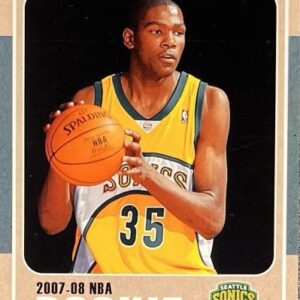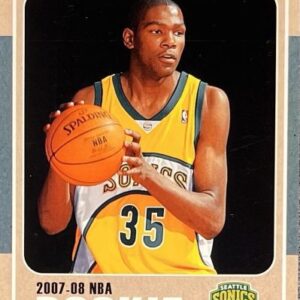There is something about certain sports cards that, even in stillness, manage to make quite a racket. One of those is Michael Jordan’s 1995–96 Flair Hot Numbers insert, card number 4 to be precise. It’s a card that practically commands attention before anyone even sees the slab it’s housed in. The reason? Its design is intentionally bold—a visual cacophony resulting from the layered lenticular printing process. This technique is remarkable for throwing light in a dance reminiscent of a scoreboard, creating a number pattern that shifts and sways with a simple tilt of the card.
Set against the backdrop of the Chicago Bulls’ legendary run, this particular piece is an aesthetic and historical marvel. This was a time when Flair, the brand responsible for this spectacle, was on a mission to elevate premium paper cards as worthy competitors against the burgeoning chromium wave. According to the venerable Beckett magazine, the Hot Numbers insert comprised a 15-card set, each with its unique three-dimensional lenticular glaze—a creative flourish that made these cards conspicuously outstanding as soon as they hit the packs.
Unlike some collectibles that thank consistent visibility for their fame, Jordan’s Hot Numbers has an aura of enigma. During its inception, these cards appeared only once in every 36 packs, making them a rarity even among dedicated collectors. When you combine this scarcity with a design that seems to shout its presence, the Michael Jordan card carves out a niche among a decade filled with unforgettable 90s inserts. Even back then, it exuded “premium pull” vibes, an urgency captured perhaps by that same exuberant 90s aesthetic.
Fast forward to today, and the market treats a PSA 10 Hot Numbers card like it’s headlining a show. Its sales have hovered around the $4,000 mark. Data from PSA’s auction history shows the latest auctions closing around $3,950, consistently keeping their value within the three-thousand-plus vicinity. Card Ladder even reported a splashy mid-summer transaction at a cool $4,800, suggesting just how much a mint condition specimen can fetch when competitive bidders are watching. All things considered, “about four grand” succinctly captures the current climate, with noticeable variances whenever a pristine card graces the auction block.
Condition plays an unmistakable role in this financial dance. The lenticular layer is clever at masking subtle lines when viewed from a flat angle, and the heavily decorated foil front can shroud minor edge wear unless under direct light. This is why savvy buyers lean into angled photos, deal with trusted vendors, and keep tabs on relevant comps rather than whimsically speculating. When a card presents itself with crisp lines and precise centering, bidders are often willing to comfortably reach that four-thousand benchmark.
But what truly makes the 1995–96 Flair Hot Numbers captivate audiences nearly three decades later is its intrinsic design. This card is quintessentially 90s for all the right reasons—real depth sans holographic trickery, layered print yielding a sense of dimensionality that persists even through the protective embrace of a top loader. Spotting it from across a show floor is effortless since its geometry and number pattern appear to be locked in a rhythm rivaled by no other Jordan inserts. Collectors who lived through the era instantly recognize its flair, whereas those newer to the hobby, exploring 90s nostalgia through Jambalaya highlights and PMG lore, find Hot Numbers a visually stimulating avenue to explore.
The historical context amplifies its charm. During its prime years, Flair was committed to demonstrating that paper cards, with adequate sophistication, could be just as enthralling as their more modern counterparts. Hot Numbers represented the pinnacle of that philosophy—you didn’t need a shiny refractor finish or intricate die-cut patterns to make an impact. Landing one of these cards in Series 1 was like hitting the jackpot. This was the kind of card you proudly displayed even amongst non-collectors, as it looked less like a sports card and more like a compact piece of graphic artwork.
Within the numerous collecting avenues, this MJ card comfortably fits several. It complements a 90s insert collection alongside cards like New Heights or Scoring Kings. It stands out in a Michael Jordan compilation as the vibrant, unapologetic counterpart to more conservative, photo-centered base issues. And if you’re diligent, it finds its home amidst a complete set pursuit—tracking down all 15 Hot Numbers in mint condition is a labor of love with immense gratification at its culmination. The checklist serves as a nostalgic snapshot of mid-90s basketball heroes.
This year, the market has maintained a clear path for these cards. eBay auction results for PSA 10s consistently settle around the $4,000 range, with price peaking occasionally when a particularly eye-catching slab enters the fray. Of course, there are the ambitious Buy It Nows and vault pricing hovering well above standard market rates—a predictable scenario for a card this photogenic. Still, the real guiding compass remains the auction pulse where pricing dynamically adjusts through competitive bidding.
If your collecting eye sharpens with attention to detail, close-up angles and edge inspection shots are critical. The lenticular front may obscure micro abrasions until the light aligns just so; the calm back is often your first guide when it comes to identifying edge wear. While slabs offer some aid in the grading realm, the truth is in the viewing. The cards that truly mesmerize in person often reflect that allure in the auction final value.
And for the ever-curious enthusiast wondering about the thrill of the chase—yes, a Jordan Hot Numbers card awaits potential discovery within our Galaxy Rip Packs. Our checklist is ever-evolving, maintaining an intriguing blend, but this piece unquestionably stands as a treasure. When it’s finally unveiled, the scene mirrors that of 1995: gatherings form, phones swiftly emerge to capture the moment, and participating viewers eagerly anticipate the card’s front dazzling display.
Investing in this card is a choice steeped in both heartfelt appreciation and financial prudence. Its enduring appeal lies in its dual prowess: a piece of art requiring no grand explanation, and a coveted market commodity that holds steady liquidity at its peak grade. Whether you decide to let its lenticular design sing solo in a well-lit display or it’s nestled among a cadre of 90s inserts, it steadfastly claims its stage, rivaling the familiar contenders. This is a card that not only earned its prestige through scarcity and the era it hails from but also by sheer visual spectacle—a vivid testament to the kind of excellence that collectors universally acknowledge the moment it graces their hands.





